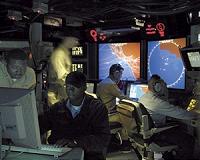 |
Jerusalem (UPI) Feb 11, 2011 The Knesset's Foreign Affairs and Defense Committee has recommended the military buy 13 batteries of the Iron Dome anti-missile system at a cost of $1.4 billion amid repeated warnings by military commanders of the threat of a major missile blitz. The acquisition of the controversial missile system built by state-owned Rafael Advanced Defense Systems will likely be spread over several years. So the decision by the powerful committee, approved in the legislature Wednesday, wasn't considered a directly consequence of the political upheaval in neighboring Egypt. But Israeli leaders fear the collapse of President Hosni Mubarak's regime could signal the abrogation of the landmark peace treaty that the Egyptian leader's predecessor, Anwar Sadat, signed in March 1979. In recent days, as Mubarak's regime came under unprecedented pressure from massive street protests, the Israeli military has been making precautionary deployments to raise the country's defense posture. The recommendation by the committee, which must be ratified by the Knesset, gave a major boost to efforts to build up Israel's planned three-tier missile defense shield amid a growing awareness that the Jewish state faces the threat of a multi-front missile assault of unprecedented proportions. The committee's action underlined the deepening concern that successive government failed to address the vital issue of missile defense, particularly for the country's population and industrial centers. The committee urged the defense ministry to adopt the Iron Dome acquisition to bolster Israel deterrence posture and, since the panel sets the defense budget, that's likely to carry significant weight with Israel's military chiefs. Iron Dome is designed to detect and destroy short-range missiles and rockets like those used by Hezbollah in Lebanon on Israel's northern front and the Palestinian Hamas group in the Gaza Strip in the south. It fires interceptor rockets to down incoming projectiles and its advanced radar fire-control is capable to distinguishing between missiles that will land in inhabited areas and those that will not, which it will disregard. The Israeli air force, whose air-defense command controls Iron Dome and other such systems, currently has only two Iron Dome batteries. It has delayed declaring them operational and says they will be stored at a central air base for emergency deployment in the event of a missile attack. But military experts say these two batteries -- all that the Defense Ministry budgeted for -- won't be enough to provide an effective defense of Israel's cities, particularly Tel Aviv, which has a population of 2 million. Tel Aviv, Israel's industrial and financial center, "will be a front line in the next conflict," the outgoing Military Intelligence chief, declared in November. Israeli officials say Hezbollah has 43,000 missiles and rockets, some capable of hitting anywhere in Israel. That's almost four times the number it had when it fought Israel in July-August 2006. Syrian and Iranian missiles can also reach Israel. The only element of the defense shield operational now is the long-range, high-altitude Arrow-2 anti-ballistic missile system. The first battery was deployed in northern Israel in 2000. The Arrow, made by state-owned Israel Aerospace Industries and Boeing, is designed to counter Iran's intermediate-range Shehab-3 ballistic missiles, of which as many as 200 are believed to be deployed. Iron Dome, intended to counter missiles with a range of up to 45 miles, has many critics. They say it has many shortcomings that make it less than effective against short-range Katyusha and Grad rockets which are only in the air for 15-20 seconds. The third component of the planned air-defense shield is the intermediate-range David's Sling, also known as Magic Wand, still being developed by Rafael and Raytheon of the United States. It's not likely to be operational until 2013. Israel recently successfully tested the weapon, designed to counter rockets with ranges of up to 150 miles. It employs Stunner interceptor missiles, developed from the heat-seeking Python 5 air-to-air weapon, manufactured by Rafael's missile division, and from the program to develop the truck-mounted, short-range Spyder anti-aircraft missile with a maximum kill altitude of 5 miles. A Spyder squadron, which costs $11 million, comprises four missile-launcher trucks, a mobile radar built by IAI subsidiary Elta Systems, and a missile resupply truck. David's Sling is designed for use against missiles and rockets aimed at large urban areas.
Share This Article With Planet Earth
Related Links Learn about missile defense at SpaceWar.com Learn about nuclear weapons doctrine and defense at SpaceWar.com All about missiles at SpaceWar.com Learn about the Superpowers of the 21st Century at SpaceWar.com
 Surface Combat Systems Center Tests Aegis BMD Capabilities
Surface Combat Systems Center Tests Aegis BMD CapabilitiesWallops Island VA (SPX) Feb 08, 2011 Surface Combat Systems Center tested the updated capabilities of the U.S. Navy Aegis Ballistic Missile Defense(BMD), Jan. 22, launching a target vehicle from NASA's Wallops Island Flight Facility as part of the Navy's Atlantic Trident exercise. The exercise provided realistic training for the participating Navy BMD ships, providing a live target to track and simulating the intercept of a s ... read more |
|
| The content herein, unless otherwise known to be public domain, are Copyright 1995-2010 - SpaceDaily. AFP and UPI Wire Stories are copyright Agence France-Presse and United Press International. ESA Portal Reports are copyright European Space Agency. All NASA sourced material is public domain. Additional copyrights may apply in whole or part to other bona fide parties. Advertising does not imply endorsement,agreement or approval of any opinions, statements or information provided by SpaceDaily on any Web page published or hosted by SpaceDaily. Privacy Statement |